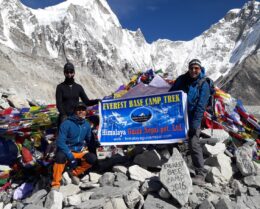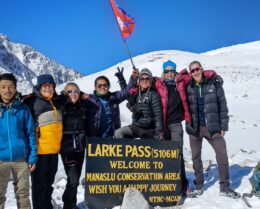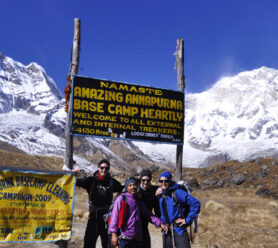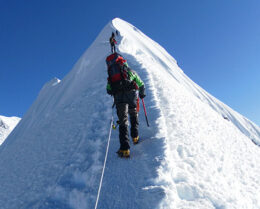Helicopter Rescue in Nepal – Rescue Operations in Nepal’s Remote Regions
PUBLISHED ON 11 April, 2024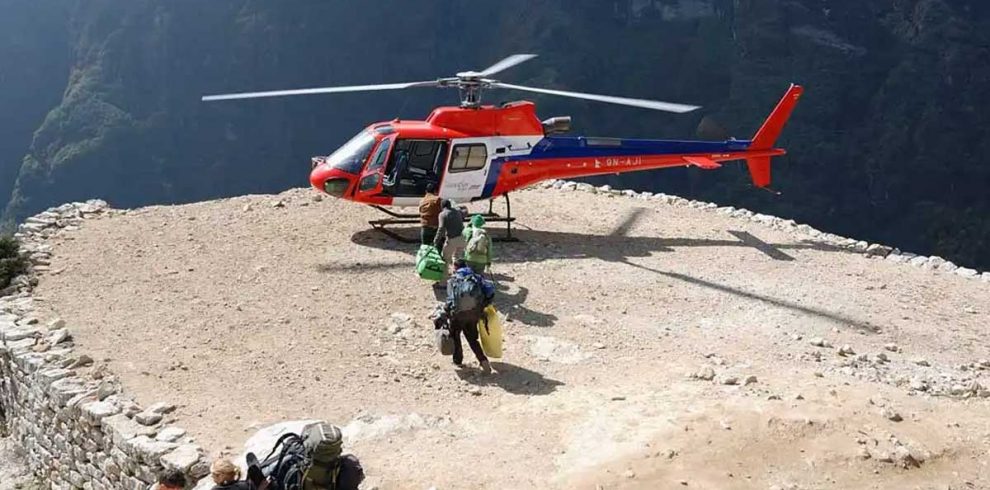
In times of emergency, we deploy our experienced team to rescue tourists from remote areas of Nepal, ensuring they receive prompt medical attention. When one of our esteemed travelers sustains injuries and requires urgent medical care, we swiftly offer helicopter assistance. Helicopter rescue operations play a crucial role in saving lives in Nepal, providing a lifeline to those in distress amidst the towering peaks and challenging landscapes.
We have complete medical safety equipment on our helicopter. And there’s the oxygen cylinder. Since there isn’t a hospital in the high-altitude mountain region of Nepal, it transports you straight to the hospital in Kathmandu City.
The Need for Helicopter Rescue:
Nepal’s remote regions are often inaccessible by road, making helicopter rescue operations the primary mode of emergency assistance. Trekkers, mountaineers, and locals alike may find themselves in precarious situations due to altitude sickness, injuries, avalanches, or unexpected weather conditions. In such instances, timely rescue becomes a matter of life and death.
Challenges of Rescue Operations:
Operating helicopters in the Himalayas presents unique challenges. The high altitude, unpredictable weather patterns, and treacherous terrain demand exceptional piloting skills and specialized equipment. Moreover, landing sites are scarce and often perilous, requiring precision and experience.
Helicopter Rescue for Altitude Sickness
Because they travel and ascend at a higher altitude, hikers and climbers may become ill in Nepal’s high, elevated Himalayan region. They require an evacuation in such a situation. If not, this illness might kill them.
Since there is no access to a road ambulance or a well-maintained hospital, the only choice is to hire a helicopter. To save the lives of hikers and climbers, we therefore provide the quickest medical evacuation and rescue service.
Helicopter for Medical Emergency
Helicopter evacuation is just one option for those extremely ill patients who are in a remote area of Nepal where neither the hospital nor road transportation is available. It is the quickest and most effective method of moving people from one location to another.
It is often known that Nepal is a hilly and mountainous nation. There are still many areas without roads and hospitals. Additionally, the locations where access to the roads is possible are likewise in poor shape, making it take a while to go to the cities. Therefore, the Medevac is required to rescue those who require immediate medical attention.
For patients who are very ill and require immediate medical attention, we provide emergency medical evacuation services. We also assist in making contact with the nearby hospital so that, in an emergency like this, you can receive immediate care.
Most renowned destinations for Helicopter rescue in Nepal
We primarily rescue tourists from Nepal’s Himalayan region who are critically ill from high-altitude problems or other causes and require an immediate medical evacuation.
The most popular locations for our helicopter rescue service are Everest, Annapurna, Manaslu, Dolpo, Kanchenjungha, Makalu, Narphu, and so forth. Whether they are foreigners or Nepalese, our primary mission is to save travelers.
Because so many people visit the Everest region, it is the most rescue area. Conversely, the second most common rescue location is the Annapurna region.
We are always prepared to offer a helicopter evacuation at any time, regardless of the circumstances.
Finally, before embarking on a journey through Nepal, we advise all hikers and climbers to purchase travel insurance that includes coverage for helicopter evacuation and your desired elevation. Since you will require a medical evacuation during your trip this type of insurance will save you the high cost of a helicopter rescue service.
Trekking Rescue in Nepal
Trekking in Nepal’s Himalayas has never been a simple task. As we investigate those locations, several things come into play. In the mountains, there is a risk of avalanches and other natural disasters. An additional prevalent issue at those higher altitudes is high altitude sickness. In addition, getting hurt is a component of hiking. While some of these problems can wait, the majority of them require emergency medical care.
The honorable mission of saving the patients from the higher elevations is made much more difficult by the geographical location. Being the most practical way to rescue people from those areas, helicopter service has been important in helping to overcome the obstacle.
In addition to these missions, we also provide medical evacuation (medevac) and casualty evacuation (casevac), which deal with getting patients from the first aid station to a hospital where they can receive additional care. Our team is quite effective and can respond to your stressful call at any time.
Members of our team demonstrate the capacity to carry out the mission at an altitude of above 8,000 meters. Therefore, you can always rely on us to provide a prompt reaction and a reasonable rescue. We do, after all, prioritize helping others before making money.
We are aware of how important our duty is. We are well aware that in such stressful situations, even a split second might be the difference between life and death. Therefore, in light of these grave circumstances, we would want to reassure you that we will make every attempt to get in touch with you as soon as possible.
We are aware that a prompt and successful rescue may end up saving a life. Consequently, we only use helicopters capable of flying to extremely high altitudes for heli-rescue missions in Nepal.
Helicopter Rescue in Four Regions of Nepal
Helicopter rescue in the Everest region
For many trekkers, reaching the Everest Base Camp is their ultimate goal. One can request an emergency helicopter rescue of victims suffering from various illnesses, such as AMS (Acute Mountain Sickness), HACE (High Altitude Cerebral Edema), infections, and water-filled lungs and brains, in the picturesque and cultural helicopter ride around high Khumbu within the Everest region.
Several ailments could arise following an ascent of more than 5,000 meters. It is advised that you avoid visiting this area if you are a patient of such a disease. It could be challenging for a pilot to land a helicopter over 5,000 meters owing to unforeseen weather as well.
Fortunately, a pilot is included in the five seats in case of a rescue flight. You will be rescued and sent to Lukla or Kathmandu for additional medical care if you have a serious illness. Everest’s higher height makes it one of Nepal’s most challenging hiking regions. For all hikers, this is a dangerous area to traverse.
Read more about- Helicopter rescue in the Everest Region
Helicopter rescue in Annapurna Circuit:
The Annapurna Circuit, renowned for its stunning vistas and cultural diversity, is a magnet for trekkers. However, its rugged trails pose risks, with altitude sickness and injuries being common. Helicopter rescue services are crucial in evacuating those in need to medical facilities in Pokhara or Kathmandu.
Read more about- Helicopter rescue in the Annapurna Region
Helicopter rescue in Langtang region
In addition to offering an incredible tour lasting a few hours, Helicopter can be called for help at any time. All you have to do is inform us of the precise location and angle for the ideal landing. A pilot should be properly informed about the precise location of patients from whom we can readily conduct rescue operations.
When compared to other areas, the Langtang Valley is not as challenging. For a seasoned pilot, a rescue in the Langtang region is not too difficult. It is not difficult to do a rescue by helicopter landing at an elevation of 3,800 meters if you employ an experienced pilot.
Although a large percentage of landings occur at a time, proper landings may not always occur on schedule due to weather forecasts.
Read more about Helicopter rescue in the Langtang Region
Helicopter rescue in the Manaslu region
Trekking in Nepal’s North-West region is particularly hazardous and perilous, as it lies near Manang and above the Gorkha district. Snowfall, landslides, and road closures brought on by flooding could end your journey. Occasionally, you may also be impacted by natural disasters.
Due to its stunning natural surroundings, this route is currently the most popular one for tourists. This region is mostly visited since Mt. Manaslu, the eighth-highest mountain in the world, is located there. This area is encircled by Annapurna to the west and Ganesh Himal to the east.
You will travel by numerous isolated communities in this area. The sole course of action in the event of a serious injury sustained while trekking is helicopter rescue. The pilot should be assigned a precise and appropriate site from which to rescue people from the lower Budhi-Gandaki River to the upper regions of Manaslu, ranging from Dyang-Lo Gaon, Sama Gaon, Samdu, to Larke Phedi, or the base of Larke-la pass, also known as Dharmasala.
There may occasionally be an issue with landing because of the worst weather and landing location. Either the Kathmandu Valley or Pokhara can be used to summon the chopper. You will be sent to the hospital for additional care following the rescue.
Read more about Helicopter rescue in the Manaslu Region
Helicopter as Air Ambulance
In the event of a rescue, the helicopter is the fastest means of providing quick assistance. In an emergency, a helicopter flight may be necessary, depending on how isolated and inaccessible the region is.
The pilot needs to have a lot of experience and be equipped with the right knowledge to land. The extra time needed for rescue will not occur if the weather is favorable. Appropriate medical teams will be on hand to manage patients’ conditions and provide care until the patient gets to the hospital.
Along with professionals providing appropriate care, there should also be adequate medical supplies, operating tables, or beds. The only issue is the weather, which makes a helicopter rescue possible. Helicopter rescue is the most expedient method of saving a life. In Nepal, air ambulance service is another name for helicopter rescue.
Rescue Helicopter
Helicopters Fleets we use for all kinds of transports and rescues: Numerous private and helicopter-operated companies exist. You will most likely receive rescue services from a variety of types, including Puma, Turbine Robinson R 66 Helicopter USA, H-125 or AS-350B3e constructed by Air-Bus Company, Airbus H125 with MSN 8477 Helicopter for commercial services, and AS 350 B series of helicopters made by Euro-Copter, France.
These helicopters are operated by numerous businesses due to their popularity. These kinds of helicopters are appropriate for rescue operations, mountain tours, and other helicopter missions.
These are a few of its attributes:
- Fantastic and reliable design
- a cozy seating configuration
- Ideal for any helicopter mission, mountain flying, and rescue operations
- comprises five seats.
- possess the ability to soar to a height of 16,000 feet
Finally, if the weather permits, helicopter rescues in Nepal are carried out as quickly as possible. In the event of an emergency, there is no need to worry about the rescue. Do not attempt to ascend to a greater altitude if you are suffering from altitude sickness. And we are here to offer you helicopter rescue in Nepal in such a circumstance.
Impact of Helicopter Rescue
The impact of helicopter rescue operations in Nepal cannot be overstated. Beyond saving lives, these operations bolster the tourism industry by instilling confidence in trekkers and climbers, knowing that help is within reach in case of emergencies. Moreover, they contribute to the overall safety and well-being of remote communities.
Challenges and Future Outlook
Despite their invaluable service, helicopter rescue operations in Nepal face challenges such as limited infrastructure, high operating costs, and weather-related constraints. However, advancements in technology and collaboration between government agencies, NGOs, and private operators offer hope for improved efficiency and effectiveness in the future.
Conclusion:
Helicopter rescue operations act as the flying angels of Nepal’s remote areas, providing a lifeline to those in need amid the towering mountain peaks and rugged landscapes. Their tireless efforts save lives, support communities, and ensure the safety of adventurers exploring the Himalayas. As Nepal continues to develop, Nepal’s rescue capabilities will also continue to evolve, reaffirming its status as a beacon of hope in the world of mountain rescue operations.

